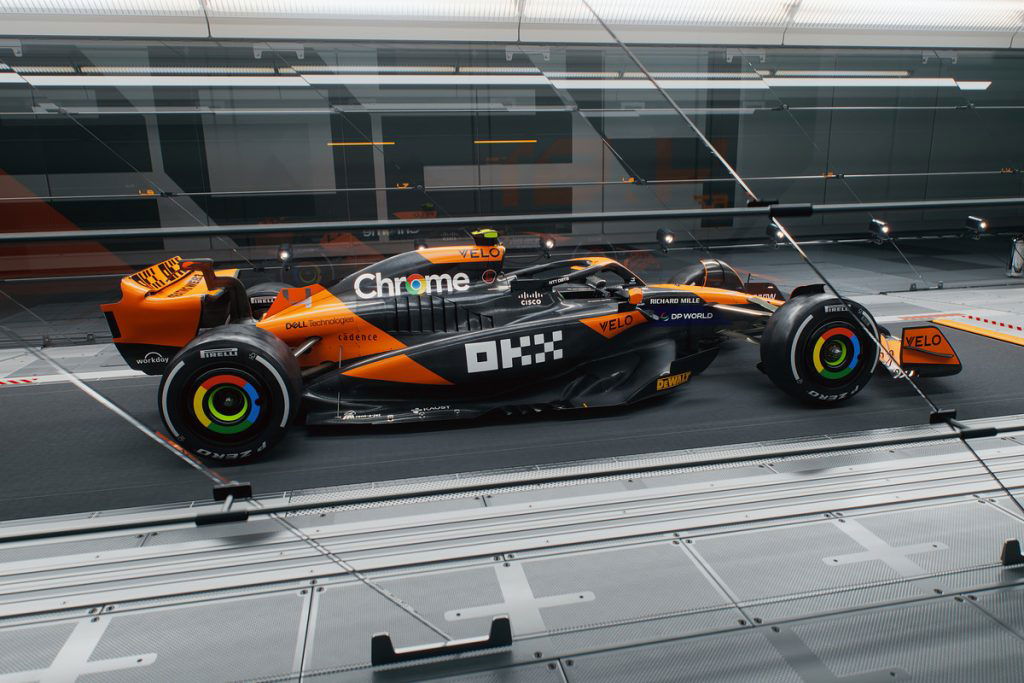

Entering the third season of the ground-effect aerodynamic regulations that were introduced at the start of 2022, the expectation has been that there would be a gradual tapering off in potential gains and a closing of the gaps across the field.
Last season, and following an honest appraisal over the winter that it was behind in the development of its MCL60, McLaren did not unveil its potential until the Austrian Grand Prix and the delivery of a major upgrade.
Subsequent significant updates were delivered in Singapore, with the combination of the two packages allowing the team to challenge for podiums and ultimately clinch fourth place in the constructors’ standings.
On the day the team revealed its livery for the MCL38, which will officially be launched on February 14, Stella made clear he and his team “don’t see any diminishing returns”, stirring optimism it can again challenge at the front of the grid.
Stella knows the numbers seen so far will only “be proven once we put the car on the ground”, but he added: “When it comes to the wind tunnel development, CFD development, we see that the gradient we established last year, that led to the Austria, and then the Singapore development, it seems like we can maintain it
“That’s where I would expect the launch car to be at the start of the season.
“In the background, we are already starting to work on further developments that we hope to bring relatively soon in season, and they also seem to be quite interesting.
“So, I would say in terms of the regulations themselves, and in terms of the development we are aiming for specifically here at McLaren, we are seeing the kind of linear gradient of development can be maintained.”
Unlike a year ago, Stella concedes that his team’s preparation so far “has been relatively smooth” and they are “on plan”, albeit still “pushing everything to the limit last minute”.
McLaren has been aided in the development of the MCL38 by its own wind tunnel, which went online in the middle of last year, and simulator.
“It’s been interesting because we have been integrating the new infrastructure that we delivered in 2023,” said Stella.
“So the MCL38 has been developed entirely at the MTC wind tunnel, certainly from September onwards, and in the new simulator, while composite and metallic parts are being produced in the new manufacturing infrastructure facilities.
“So that’s a really exciting element heading into the 2024 season.”
In addition, McLaren brought in new hires Rob Marshall from Red Bull as technical director of engineering and design, while David Sanchez has joined from Ferrari as technical director of car concept and performance.
With the impact of their appointments expected to be felt over the year, Stella added: “Hopefully, all these ingredients will participate in making our team more competitive, and deliver a better car than last year’s.”
For Stella, who was only appointed as team principal 13 months ago following the departure of Andreas Seidl to Sauber as Group CEO, there is a degree of calmness heading into the new season compared to a year ago, aided by the overall progress of the MCL38.
There is also an overall sense of confidence building as Stella said: “This time last year, we could see the numbers that we could quantify quite well from an aerodynamic point of view when it comes to efficiency and downforce drag, had a period of plateauing.
“From a conceptual point of view, we needed to change the direction as such that we could recover this momentum in terms of development.
“This year we haven’t experienced this kind of plateauing in the development tracker and gradient.
“At the same time, from a conceptual point of view, we have seen the concepts we had in establishing last year’s car have quite a lot more to offer, just in incremental gains that you can cash in.
“Also, some new ideas have popped out in the technical department, which is the foundation for the upgrades that we will see in season, and some of them, I would expect to be relatively early in the season.
“So (it is) a completely different scenario (to a year ago), not only in terms of subjective perception, if you want, of the organisation, but I would say, even from a numerical point of view where we see decent progress.”






















Discussion about this post